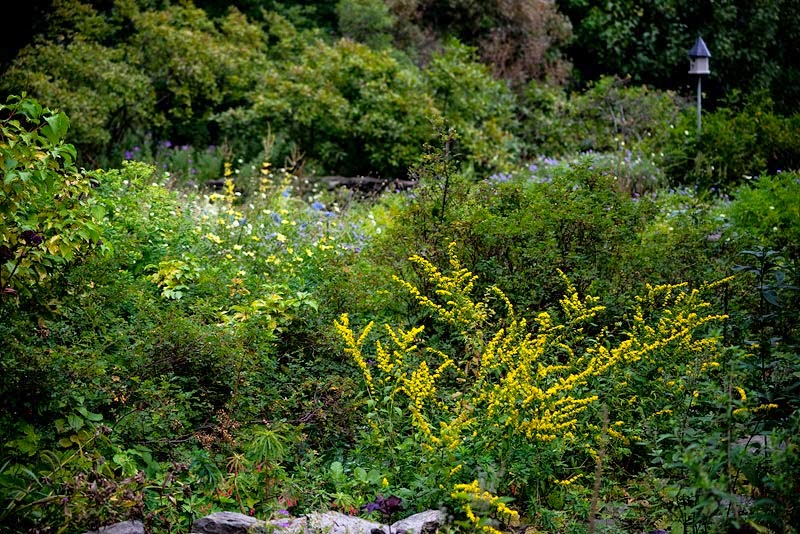 |
| Wisps of fog rise from the valley below us, at sunrise. Neither the Hudson River School nor Chinese scroll painters were making this stuff up. |
 |
| Calamintha nepeta 'Gottlieb Friedkund' around the rain gauge |
 |
| Seed heads of Rabbit's Foot Clover, Trifolium arvense, contrast with the strong stone driveway edging-- the volunteer trifolium are on the driveway side of the edging! |
 |
| Coreopsis tripteris, Tall Coreopsis, in the west meadow |
 |
| Hummingbird perched on trumpetvine on the back deck |
 |
| The fenced garden from a studio window |
 |
| Coreopsis tripteris, Tall Coreopsis, in the big island bed, with Clematis terniflora, Sweet Autumn Clematis on the arbor and Heptacodium miconiodes behind |
 |
| Heptacocium miconiodes and Clematis terniflora, Sweet Autumn Clematis-- both white, both fragrant |
 |
| Sweet Autumn Clematis, Clematis terniflora, close up |
 |
| Heptacodium miconiodes |
 |
| Symphyotrichum oblongifolium 'Dream of Beauty', a pink, low growing form of the reliably deer-resistant Aromatic Aster (the species is usually lavender-blue) |
 |
| A eupatorium corner off the driveway: Eupatorium chinense, Hemp Agrimony, on the left, and white Eupatorium aromaticum 'Jocius' Variegated' on the right |
 |
| Actaea pachypoda, White Baneberry, where the driveway passes through the woods |
 |
| Eurybia divaricata, White Wood Aster, along the driveway. Yes, this was Aster divaricatus, and I still think of it so. |
 |
| The white variegated foliage of a cultivar of a fully herbaceous caryopteris, Caryopteris divaricatus 'Snow Fairy', is fresh and cool all season, far into the fall. |
 | |
| Looking across the gravel entry courtyard to an arbor of Sweet Autumn Clematis, Clematis terniflora, that marks the opening of a curving path with Hydrangea paniculata 'Pink Diamond' |
 |
| Clouds over the valley below can still look like summer. |
 |
| Looking out to the east meadow from our basement plant room |
 |
| The true blue of Salvia azurea 'Nekan', Blue Sage, by the east garden steps |
 |
| Sorghastrum nutans, Indiangrass, catches the light in the meadow beside the circle terrace |
 |
| Salvia azurea 'Nekan', Blue Sage, almost as clear in color as the September sky behind |
 |
| Some of the plants in our patch of putative Colchicum byzantinum have broader petals, and may be the cultivar C. 'Autumn Herald'. |
 |
| Indigofera 'Little Pinkie' just keeps blooming more heavily as the season advances. |
 |
| Looking across a goldenrod-dominated section of the west meadow and a corner of the fenced garden with late yellow daylilies to the farm fields of Hawthorne Valley and the hills beyond |
 |
| That seasonally moist stretch of the east meadow also includes Rudbeckia laciniata, Green-headed coneflower. |
 |
| One of our favorite goldenrods, Solidago juncea, Early Goldenrod, in the west meadow |
 |
| Rudbeckia laciniata, Green-headed Coneflower, in the west meadow |
 |
| Another favored goldenrod here is Solidago caesia, Wreath Goldenrod, which grows in partial shade. |
 |
| Colchicum byzantinum (or, perhaps, C. byzantinum with C. 'Autumn Herald') |





















No comments:
Post a Comment